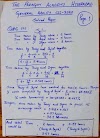PPSC Chemistry Lecturer Past Papers
Punjab Public Service Commission (PPSC) and Sindh Public Service Commission (SPSC) is going to announce Lecturer exams very soon. Previously, SPSC and PPSC have conducted lecturer exams.
Qualifications for PPSC SPSC Lecturer:
Candidates having a masters degree, in particular, are eligible to apply in that subject lecturer post.
Usually, Lecturer is taken as a subject specialist that's why students having a particular subject degree are eligible to apply.
How to prepare for the SPSC PPSC Lecturer Exam:
Sindh Public Service Commission (SPSC) and Punjab Public Service Commission (PPSC) have conducted lecturer exams in past.
So, It is not difficult to get an idea about the paper pattern of both SPSC and PPSC lecturer exams.
If you are applying for SPSC Chemistry Lecturer Exam then you should follow SPSC Chemistry Lecturer Past Papers.
But, If you are going to appear in the PPSC Chemistry lecturer exam then you should follow PPSC Chemistry Lecturer Past Papers.
This post will be updated, again and again, we will add all Punjab Public Service Commission (PPSC) and Sindh Public Service Commission (SPSC) Chemistry lecturer exam past papers.
We are starting with PPSC Lecturer Chemistry 2015 Past Paper MCQs.
PPSC Lecturer Chemistry Paper 2015
PUNJAB PUBLIC SERVICE COMMISSION LECTURER CHEMISTRY (BS-17)
Time: 120 minutes
Total Questions: 100
Read QUESTION PAPER carefully and mark your answer on the ANSWER SHEET.
Each question has four options.
Fill in only one box that you think is the correct answer.
Each question carries 1 mark. 0.25 mark will be deducted for each incorrect answer.
1. Enzymes are:
(A) Fatty acids
(B) Vitamins
(C) Proteins √
(D) None of these
2. Enzymes belong to which class of compounds?
(A) Polysaccharides
(B) Polypeptides √
(C) Poly nitro heterocyclic compounds
(D) Hydrocarbons.
3. The Helical Structure of protein is stabilized by.
(A) Peptide bonds
(B) Dipeptide bonds
(C) Hydrogen bonds √
(D) Van der Waals forces
4. The function of enzymes in the living system is to.
(A) Transport oxygen
(B) Provide immunity
(C) Catalyze biochemical reactions √
(D) Provide energy
5. Which one of the following vitamins checks nights blindness?
(A) A √ (B) B (C) C (D) D
6. Which of the following is an example of Zwitter lon?
(A) Alanine
(B) Glycine hydrochloride √
(C) Both A and B
(D) None
7. What does IR spectroscopy allow us to determine?
(A) The number of carbons in a compound
(B) The Kinds of bonds in a compound
(C) The molecular formula of a compound
(D) The carbon-hydrogen framework of a corm pound √
8. March gan contains:
(A) CO
(B) C2H2
(C) CH4 √
9. Which of the following solvents in the best to use when taking IR spectrum
(A) CC4 √
(B) Methanol
(D) Ethanol
(C) Water
10. A Strong peak between 1700 and 1760 cm. An infrared spectrum most likely indicates: (A) The presence of an alkene
(B) The presence of a saturated compound
(C) The presence of an alkyne
(D) The presence of a carbonyl compound √
11. What type of radiation is used in Nuclear Magnetic Resonance Spectroscopy
(A) Visible light
(B) Ultraviolet light
(C) Radio waves √
(D) Microwaves
12. Experimental evidence for the existence of atomic nucleus comes from:
(A) Millikan's oil drop method
(B) Atomic absorption spectroscopy
(C) The magnetic bending of cathode rays
(D) Alpha scattering by a thin metal foil √
13. Which of the following is false in the case of an electron?
(A) It is a particle
(B) It has a wave property
(C) It emits energy while moving in orbital √
(D) Its motion is affected by a magnetic field
14. Which of the following is a whole number? (A) Atomic weight
(B) Atomic number √
(C) Atomic radii
(D) Equivalent weight
16. Electronic configuration of M ion is 2,8,14 and its atomic weight is 56 amu. The number of the Neutron in the nucleus is.
(A) 30 (B) 32 - √ (C) 34 (D) 42
16. The ratio between the neutrons present in C and St with respect to atomic masses 12 and 28 is:
(A) 3:7 √ (B) 7:3
(C) 3:4 (D) 6:28
17. The Energy required to separate the nucleons from a nucleotide is called:
(A) Nucleus energy
(B) lionization energy
(C) Binding energy √
(D) Mode
18. The stability of the nucleus mainly depends on the number of:
(A) Proton and Neutrons √
(B) Neutrons and Electrons
(C) Protons and Electrons
(D) All of these
19. The difference between the total mass of the particle present and the real mass of an atom is called:
(A) Mass (B) Energy
(C) Mass defect √ (D) Binding energy
20. A certain mass of gas occupies a volume of 2L at S.T.P keeping the pressure constant at what. the temperature would the gas occupy a volume of 4 L?
(A) 273°C (B) 546°C √
(C) 50°C (D) 100°C
21. The difference between crystalloid and colloid is of:
(A) Solubility (B) Diffusion
(C) Particle size √ (D) Chemical Composition
22. A liquid is found to scatter a beam of light but leaves no residue when passed through filter paper. The liquid can be described as:
(A) True solution √
(B) Colloidal solution
(C) Suspension
(D) Oil
23. At equilibrium which of the following reaction is not affected by pressure:
More PPSC Lecturer Past Papers and Part.2 of Punjab Public Service Commission PPSC Chemistry Lecturer Past Paper 2015 is uploaded HERE











0 Comments